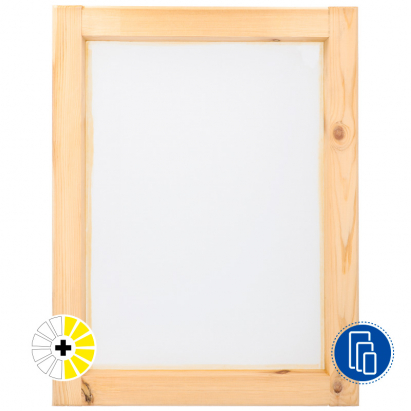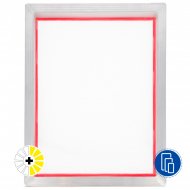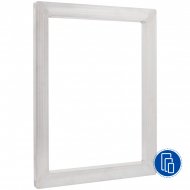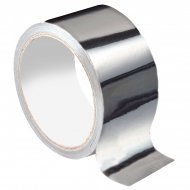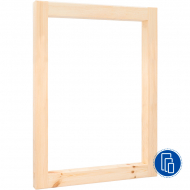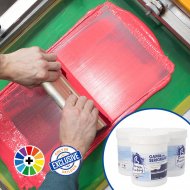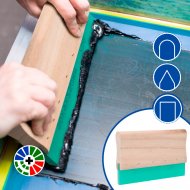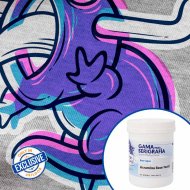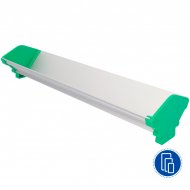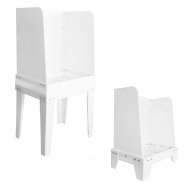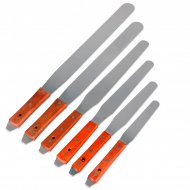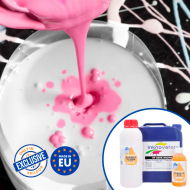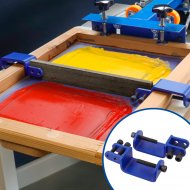
Wooden Screen Printing Frames
Screens for screen printing with a wooden frame, the most economical and eco-friendly option. Frames covered with high-quality polyester mesh, using precision mechanical tensioners to ensure perfect regularity in fabric tension.
- Internal dimensions (cm): 20x30 - 30x40 - 40x50 - 50x60
- Available in a wide variety of size and mesh combinations
- The most recommended for textile printing is the 43 threads
- Notched frame for greater flatness and strength
- Glued fabric, without staples
More information about the Wooden Screen Printing Frames
INDEX
> How to choose the right screen
DESCRIPTION
- Ash wood frames with bevelled edges for comfort and safety in handling
- Frames with tufted joints to reduce the possibility of warping
HOW TO CHOOSE THE RIGHT MESH
- As a quick reference guide:
- Textile screen printing (plastisols or pigment-heavy lacquers): 43 threads
- Graphic screen printing (water based inks for paper): 90 threads
- Industrial screen printing (solvent inks), textile four-colour, halftone: ≥90 wires
If you want to go a little deeper:
- The mesh is the screen fabric. The printing ink passes through it during printing. They are made with polyester or nylon threads. The meshes of our screens are made of 100% polyester monofilament yarns.
- The meshes are classified according to the openness of the weave, which is measured in number of threads per centimetre. In screen printing, we use meshes between 10h and 200h/cm.
- The more threads, the smaller the openings will be, leaving less space for the ink to pass through. Conversely, fewer threads mean larger openings.
- To print designs with a lot of detail or definition, it is advisable to use a mesh with more threads, which is more closed. On the other hand, a mesh with fewer threads is more open and recommended for printing less elaborate images such as lettering, text or geometric shapes. A design with details or small lettering requires a mesh size larger than 60 mesh for a good result.
- The type of ink also influences the mesh count recommendation:
- More liquid inks, such as water-based inks, acramine and lacquers, pass well through small holes, which allows for more thread counts. With these inks, mesh sizes up to 90h are used.
- Plastisols are denser and require a lower mesh count.
- If you need more definition, you can combine the use of solvent inks with a tighter mesh, as these can pass through more easily.
You can also learn more about this topic in this post of our blog.
FREQUENTLY ASKED QUESTIONS
What is the difference between white and yellow mesh?
Yellow mesh does not refract light and allows for more definition in very complex designs.
What size screen do I need?
The choice of frame size, also known as shablon, depends on the size of the image you want to print.
To the size of the image you have to add 15 or 20 cm per side to get the size you need.
Example: for an image of 30x40cm, it is advisable to use a frame measuring at least 45x55cm. In this case, the 50x60cm frame would be suitable.
At what tension are the screens stretched?
Generally, the screens are tensioned to 27 newtons. The recommended tension value varies according to the size of the screen, the weft, the frame material and the surface on which the screen is to be printed.
Just as important as the tension is its evenness over the entire surface and stability over time.
What happens if a screen arrives damaged in transit?
The procedure is the same as for any package you receive from us: if the package is already visibly damaged before you open it, do not sign for it. And if you decide to do so for any reason, please state this in writing on the delivery note. If the damage was not visible until you opened the package, call us or send us an email immediately to inform us so that we can resolve the situation in the most convenient way for both of you. You have 10 working days to claim transport damage.
Two screens have arrived stuck together, what should I do?
Don't worry, it's easy to solve. Take them out of the package and separate them from the others. Don't try to separate them by pulling on the frames. Instead, gently tap them on the ground at a slight angle. This should separate them without damaging them. If this doesn't work, contact us.
TECHNICAL DATA
MEASUREMENTS OF THE SCREENS
| Measurements inside (cm) |
Cross section of profile (cm) |
| 20 x 30 | 2,5 x 2,5 |
| 30 x 40 | 2,5 x 3,5 |
| 40 x 50 | 3,5 x 4,5 |
SCREEN WEFTS
|
Quantity Threads |
Thickness Yarn |
Opening Mesh |
Surface Free |
Thickness Fabric |
Volume Ink |
|
| per cm |
per inch |
µ |
µ |
% |
µ |
cm3/m2 |
| 10 | 25 | 300 | 716 | 49 | 468 | 232 |
| 11 | 28 | 250 | 660 | 52 | 470 | 247 |
| 12 | 30 | 250 | 600 | 49 | 490 | 244 |
| 15 | 38 | 200 | 468 | 49 | 360 | 176 |
| 21 | 53 | 140 | 339 | 50 | 270 | 135 |
| 24 | 61 | 140 | 276 | 44 | 220 | 96 |
| 27 | 69 | 120 | 248 | 45 | 210 | 95 |
| 32 | 81 | 100 | 213 | 46 | 180 | 83 |
| 40 | 102 | 80 | 169 | 46 | 160 | 73 |
| 43 | 110 | 80 | 150 | 42 | 140 | 59 |
| 49 | 123 | 70 | 136 | 43 | 135 | 58 |
| 51 | 130 | 70 | 125 | 41 | 140 | 57 |
| 54 | 137 | 64 | 121 | 42 | 115 | 49 |
| 54 | 137 | 70 | 115 | 38 | 135 | 52 |
| 58 | 148 | 64 | 107 | 39 | 120 | 46 |
| 58 | 148 | 70 | 101 | 34 | 140 | 48 |
| 61 | 156 | 64 | 98 | 36 | 115 | 42 |
| 61 | 156 | 70 | 92 | 32 | 140 | 45 |
| 68 | 172 | 55 | 92 | 39 | 91 | 35 |
| 68 | 172 | 64 | 83 | 31 | 120 | 38 |
| 71 | 180 | 55 | 86 | 37 | 105 | 39 |
| 73 | 185 | 55 | 82 | 35 | 100 | 35 |
| 77 | 195 | 55 | 75 | 33 | 105 | 34 |
| 81 | 206 | 55 | 68 | 30 | 105 | 32 |
| 90 | 230 | 48 | 62 | 31 | 78 | 24 |
| 103 | 255 | 40 | 59 | 35 | 60 | 21 |
| 110 | 280 | 35 | 55 | 37 | 51 | 19 |
| 110 | 280 | 40 | 50 | 30 | 60 | 18 |
| 120 | 305 | 35 | 48 | 33 | 55 | 18 |
| 120 | 305 | 40 | 43 | 26 | 61 | 16 |
| 130 | 330 | 35 | 41 | 29 | 58 | 16 |
| 140 | 355 | 35 | 36 | 25 | 59 | 15 |
| 150 | 390 | 35 | 30 | 21 | 65 | 13 |
| 165 | 420 | 33 | 27 | 20 | 60 | 12 |
| 180 | 460 | 30 | 25 | 20 | 55 | 11 |
| Ref. | 944045 |
|---|

